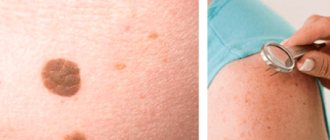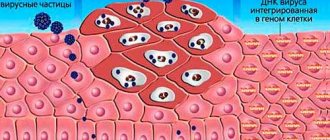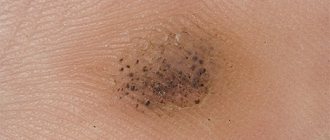Papilloma has turned black - a fairly common complaint that can be heard from patients visiting a dermatologist’s office.
Most people with these benign skin growths know that they can become malignant.
Therefore, they treat any changes with great caution.
Naturally, a change in color inevitably causes not only caution, but also well-founded fears.
Why benign formations can turn black, and what symptoms this can be combined with, patients are often interested in.
What tests should I undergo to make sure there is no danger to life, and what are the possible consequences?
Why do papillomas turn black?
To understand the reason why the papilloma has darkened, you need to know what it is. This is a skin growth characterized by rapid growth, changes in skin color and relief, which can disappear without a trace on its own. HPV is one of the most common viruses that infects the human body. The reasons why papillomas darken may be as follows.
Injury
Since the formation is mainly located on the skin, it is often subject to trauma, which is a prerequisite for its malignancy. When the tumor darkens and small red dots form on its top, this means that it may bleed if there is an injury. In such a situation, the area should be disinfected. Chlorhexidine is suitable as an antiseptic. If the wart has turned completely black, for example as a result of frequent injury, it is better to consult a doctor.
Papilloma does not always turn black due to malignancy. If you have injured a benign papule, darkening may be a sign of infection.
Inflammation
If the papilloma turns black and hurts, and there is redness and a local increase in temperature around it, this indicates the addition of a secondary infection and the beginning of the inflammatory process. A change in the color of papilloma does not always indicate its oncogenicity. But even if it is inflammation, you should consult a doctor.
If you notice that your papilloma has begun to turn black, immediately visit a doctor!
Rebirth
Transition to a malignant neoplasm is the most dangerous complication. The papilloma turns black due to internal or external reasons.
Internal reasons:
- chronic inflammatory diseases;
- inadequate treatment of HPV;
- decreased immunity;
- failure of the endocrine system;
- stress, depression;
- hereditary predisposition;
- hormone imbalance.
External factors:
- environmental pollution;
- long-term exposure to chemically active substances, antibiotics, carcinogens;
- constant friction of shoes and clothes in the area of the build-up.
What to do if a papilloma comes off?
If the papilloma does come off for some reason, you should definitely treat the damaged area with an antiseptic solution and make every effort to stop the bleeding. Then a bandage with a healing composition is usually applied to the injured area and any stress on the epidermis in this area is eliminated. After performing all the manipulations described above, you should definitely contact a specialist who will suggest a truly effective way to treat papillomas and warts.
Medical offers its clients laser correction of papillomas of any location. This technique is successfully used all over the world due to its effectiveness, non-invasiveness and simplicity. Our clinic is equipped with the latest laser equipment, which guarantees strict selectivity of the beam, which helps to avoid the formation of scars and scars, and makes it possible to use the laser even on open areas of the body.
"NEOMED" is the best medical care for you and those you care about!
Find out the cost of the procedure “Removal of tumors”
Other cases
The neoplasm may turn black even if it has died and will disappear in the near future. Why is this happening? Because the human immune system was still able to overcome the virus.
The growth is swollen and painful
In the case when the papilloma turns black and hurts, the skin around it is inflamed and hot, we can talk about infection. Therefore, it is necessary to urgently treat the wound to avoid suppuration.
The papilloma turned black and fell off
The papilloma turns black, does not hurt, does not increase in size, is not inflamed, there is no local temperature, but has it disappeared on its own? All this speaks of self-healing. Carefully observe the area where the growth was located for a while, and if there are any changes, consult a dermatologist.
Changed color and dried out
Another option for the natural death of a wart. The papilloma has turned black and dried out, does not hurt or become inflamed, but does not fall off. In this case, you also need to contact a dermatologist. Perhaps the top layer died, but the pathological process did not end.
Diagnostics
Nowadays, there are many methods that allow us to detect the HPV virus in the human body, as well as determine how dangerous it is to the health of the carrier.
The most common methods include:
- HPV testing using polymerase chain reaction. This method allows you to recognize oncogenic viruses, as well as determine the type of growths, their quality and quantity.
- Cytological studies of growths.
- General blood and urine tests, scrapings from a gynecologist.
- Tissue biopsy for cancer cells.
- Colposcopy and ultrasound diagnostics.
- Digene-test.
When to worry
In some cases, you need to consult a doctor immediately:
- rapid change in the shape and size of the growth;
- violation of the integrity of the neoplasm;
- burning, itching in the area of the wart, it began to hurt;
- long-lasting inflammation around the tumor;
- local increase in temperature;
- the appearance of bloody or serous discharge;
- if the papilloma has turned black.
- How is diagnostics carried out?
If the papilloma darkens, it is advisable to contact a dermatologist, who will evaluate the appearance of the tumor and prescribe additional tests. Diagnostics includes the following procedures:
- PCR analysis will provide information not only about the presence or absence of human papillomavirus, but also about its type.
- After removal surgically or after tearing off at home, the formation is placed in a sterile bag and taken to the oncology clinic for histological examination to confirm the diagnosis.
And is it possible to remove benign epidermal tumors on your own?
Having noticed specific neoplasms on the skin, which in medicine are called papillomas, many patients strive to cut or rip off the epidermal growth on their own, believing that such actions will lead to the disappearance of this defect. In addition, the Internet is actively discussing questions about what will happen if a papilloma is torn off and whether it is worth contacting a specialist if the papilloma comes off accidentally. Due to the relevance of such information, we will try to sort it out.
Removal of blackened papillomas
What to do if the tumor is very disturbing? It's better to remove it. There are a huge number of possible options for removing papillomas, both blackened and benign.
Conventional excision
This method of treating malignant blackened papillomas involves excision of the tumor with a portion of healthy tissue. The operation is performed under local anesthesia and takes 10-15 minutes. The vessel from which the tumor grew and fed is cauterized using electrocoagulation. The postoperative wound is treated with an antiseptic.
Laser surgery
Laser removal of the growth can be carried out if there is no inflammation around the tumor. The area of the body where the papilloma is located is anesthetized, after which they begin to burn out the papule along with the root. A very effective method of treating benign neoplasms.
Cryodestruction
Treatment of warts is carried out using cold through cryodestruction. A dermatologist treats the papilloma with liquid nitrogen for 5-15 seconds. Liquid nitrogen is supplied to the skin formation through a cryoprobe, the temperature of which is –196 degrees. Nitrogen freezes the papilloma cells and they are destroyed. After removal, the site turns white, skin redness and swelling occur, a blister and soreness appear. For a week, the wound is treated with boric acid twice a day. After 4 days, the bubble bursts, and in its place a crust forms, which closes the wound.
Radiosurgery
The most gentle removal method. The surgical field is treated with an anesthetic and the papilloma is cut off at the root using a radio knife. Removal is painless, there is no risk of infection, since the instruments do not touch the wound.
Electrocoagulation method
Removal of formation using electric current of a certain frequency. The electrocoagulator dries out the narrow base or the entire papilloma, after which the growth is easily removed. Bleeding can be prevented, since the vessels are cauterized along with the growth. Rehabilitation is completed in 7-10 days. During this period, you need to treat the wound with calendula tincture two to three times a day.
Drug treatment
After removing warts, it is imperative to undergo drug treatment, since HPV is not only located at the site of papule formation - it constantly lives in the body and waits for the moment when the immune system weakens. Therefore, therapy must be comprehensive.
- antiviral therapy - oral tablets are prescribed that prevent the virus from multiplying;
- immunostimulants in the form of tablets and drops – strengthen the body’s defenses;
- complex vitamins.
Causes of papillomas
Naturally, the main cause of the formation of growths is HPV, but the carrier of the disease may not even be aware of the presence of the disease for a long time. There are certain factors that provoke the development of growths on the body.
The causes of papillomas are as follows:
- stress and depression;
- promiscuous sex life;
- decreased immunity;
- chronic infectious diseases;
- long-term use of antibiotics;
- gastrointestinal diseases;
- relaxation in public places: baths, beaches, saunas, swimming pools, etc.
As you can see, there are not so few reasons. Although papillomas have a wide variety of causes, when several factors described above are combined, the number of benign tumors on the body can increase several times.
Dangerous symptoms and complications
Under the influence of the considered factors, an inflammatory process develops in the tissues of the neoplasm, which is characterized by typical symptoms:
- the papilloma has turned red and dried out (this often happens when the upper layers of the skin are traumatized, then the formation becomes covered with a crust);
- increased in size, swollen;
- the inflamed area may hurt and itch both under mechanical stress and in a calm state;
- the patient may experience a slight increase in body temperature (no more than 37.5 degrees).
With such symptoms, you should consult a doctor for timely treatment. If help is not provided, the situation will progress - if the papilloma is inflamed, then this condition is unlikely to go away on its own. In this case, other symptoms that are more dangerous may appear:
- blood is released from the neoplasm;
- suppuration develops;
- the increase is occurring at a very rapid pace;
- the inflamed papilloma begins to hurt more;
- there is a change in the color, shape and texture of the formation (the most common situation is darkening).
The described signs, especially in combination, indicate malignancy of papilloma, that is, its transformation from a benign to a malignant form (some HPV strains have an extremely high degree of oncogenicity).
Degeneration is the most dangerous complication; it carries risks not only for the health, but also for the life of the patient, so you should not delay when the first symptoms of the inflammatory process appear.
Treatment measures
Tearing off black papillomas is strictly prohibited. This should not be done even if the wart has already fallen off and does not adhere well to the skin. It is necessary to disinfect the growth with any antiseptic, cover it with an adhesive bandage and go to see a doctor who will help find out the cause of the changes in the appearance of the tumor.
If the papilloma separates from the skin on its own, it must be preserved and taken for analysis, which will determine whether there are cancer cells in the growth. A study for the presence of a malignant process should also be carried out if the blackened wart does not fall off. A positive result of diagnosing a cancer tumor requires immediate contact with an oncologist and appropriate specific therapy.
The following procedures will help get rid of the growth:
- excision with a radio wave knife;
- cryodestruction;
- laser removal;
- electrocoagulation.
After removal using any of the above methods, the wart completely disappears, the skin is restored within 2-4 weeks. During the rehabilitation period, careful care of the skin is necessary to speed up healing and prevent wound infection.
If for one reason or another these methods of eliminating tumors are not suitable for the patient, the doctor may recommend external treatment with medications that necrotize the tissue of the skin growth and cause its complete death. The list of products that help remove warts includes:
- Verrucacid;
- Feresol;
- Cryopharma;
- Podophyllin;
- Salipod;
- Collomak.
Additionally, antiviral and immunomodulatory agents of local and systemic action are used (Panavir, Aldara, Viferon, Genferon, Immunomax).
With the permission of the attending physician, you can use traditional medicine recipes. To remove the tumor, the tip of the papilloma is lubricated with the juice of celandine, potato, garlic, essential oils of tea tree, eucalyptus, apple cider vinegar, ammonia, castor oil. You can also make compresses with crushed aloe and Kalanchoe leaves, applying gauze with plant pulp to the warts at night.
Prevention
As preventive measures to avoid contracting HPV infection, it is recommended to do the following:
- adolescents over 10 years old are vaccinated in three stages before their first sexual contact;
- if you are sexually active, visit a gynecologist at least once a year;
- use personal protective equipment during sexual contact;
- When HPV infection is detected, it is necessary to carry out high-quality treatment.
Regardless of the chosen treatment method, it is recommended in any case to show the formations to a specialist. A dermatologist will assess the level of health risk and prescribe the correct treatment. If you injure a growth on your own, it is also recommended to seek advice. Remember, if a papilloma itches but does not fall off, it means that degeneration is occurring inside the growth, resulting in oncology. If the papilloma has fallen off on its own and nothing bothers the person, there is no need to worry.










